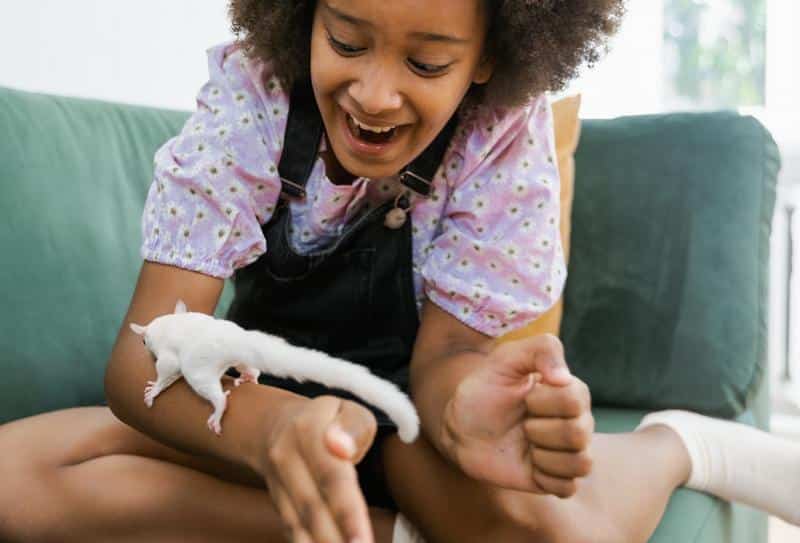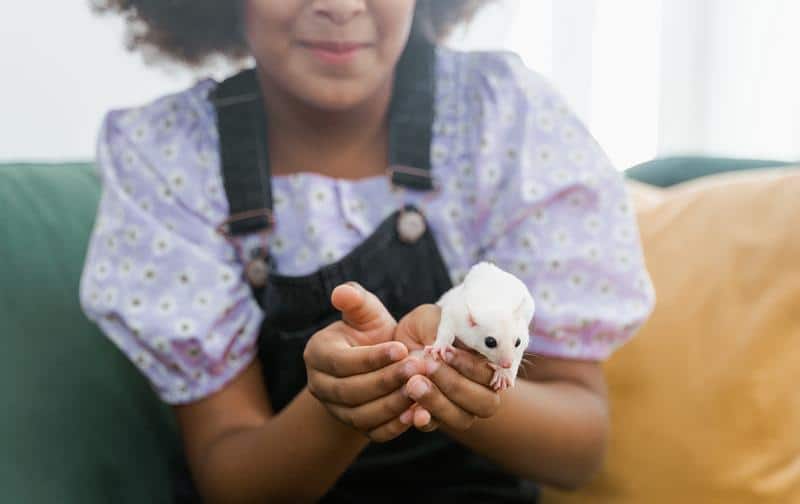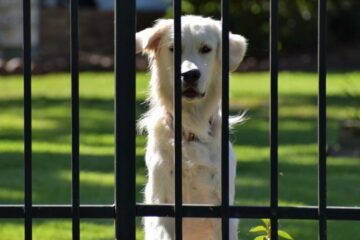Sugar Gliders and Dogs: Can They Get Along? (Yes!)
Can sugar gliders and dogs get along and live together in the household? Yes! And in this article, we’ll teach you the proper care and training to make your home a peaceful, happy place for both your pets. In addition to the commands you’ll need to know and how to use them, we’ll fill you in on how to introduce sugar gliders and dogs.
Other subjects we’ll cover include tough but necessary information to know such as do dogs eat sugar gliders and are sugar gliders good with dogs. If your dog won’t stop barking at your sugar glider, then we’ll explain what’s going on and how to handle it too. Keep reading for all this and more!
Sugar Glider and Dogs: Keeping the Peace

Your sugar glider and dogs can live together in a harmonious household, but it requires vigilance, patience, and proper training. Given that dogs are naturally curious and may perceive smaller creatures as prey, introducing a sugar glider to a home with a dog needs careful handling. Training your dog to respond to commands like ‘leave it’ or ‘stay’ is important.
Sugar Glider and Dogs: Understanding their Natural Instincts
Your sugar glider and dogs have very different instincts. While a sugar glider is a small, nocturnal marsupial that loves climbing and gliding, dogs are naturally curious predators. Dogs may be intrigued by the unique movements and sounds of a sugar glider, potentially provoking an unwanted response.
Training Your Dog to Respect the Sugar Glider
Training your dog to respect the presence of the sugar glider is critical for a peaceful coexistence. You can use the ‘leave it’ command, for instance. To teach this command, hold a treat in a closed fist and present it to your dog.
When they try and fail to get the treat, say ‘leave it.’ Once your dog backs away, reward them with the treat and praise. With consistent practice, this can teach your dog to refrain from bothering the sugar glider.
Always Supervise Interactions
Due to the significant size and instinctual differences, it’s vital to supervise any interaction between your sugar glider and dogs closely. Never leave them alone together. Even a well-intentioned playful move from your dogs can inadvertently harm your sugar glider due to their delicate nature.
Provide Separate Spaces
Sugar gliders and dogs should have their own designated areas in your home. Keeping the sugar glider’s cage in a high place, out of reach of the dog, can help prevent any unwanted incidents and reduce stress for the sugar glider.
These steps will help your dog get along with your sugar gliders, but it’s important to remember that the underlying behavioral issues (prey drive, anxiety, overexcitement, etc.) that were causing all of this to begin with will still be present. And until you address those, any positive changes you see are only going to be temporary.
“Well, how do I make these changes last?”
By getting your dog to truly choose to follow your direction, that’s how. I tried many times to write out how you can do this before deciding it made more sense to just link you to the free video series that explains it better than I’d ever be able to.
The series is by a man named Dan who is one of the world’s leading dog obedience trainers. In it, he teaches you how to put an end to things like when your dog gets too overexcited with your sugar gliders and all other misbehavior using his fast and easy-to-follow methods.
In the first video, Dan will reveal to you why the two most common methods of dog training only doom you to failure. You can watch the video now by clicking here. Follow the proven system he’ll show you in his series and you’ll never have to spend another second worrying about your dog not getting along with your sugar gliders ever again!
Are Sugar Gliders Good With Dogs?

Whether sugar gliders are good with dogs largely depends on the dog’s temperament and the careful introduction and supervision provided by the owner. While it’s possible for sugar gliders and dogs to coexist peacefully, you need to understand that dogs, being predators, may naturally see sugar gliders as prey due to their small size and unique movements.
Sugar Gliders and Dogs: A Matter of Temperament
The success of a sugar glider and a dog living harmoniously is primarily determined by the dog’s temperament. Dogs that are calm, well-trained, and have a lower prey drive are typically better suited for cohabitation with small, delicate animals like sugar gliders. However, even with the most placid dog, careful supervision is necessary during any interaction.
Introducing a Sugar Glider and Dogs
Introductions should be done slowly and methodically. Start by letting your dog get used to the smell of the sugar glider through a closed door or with a piece of bedding. Then, supervised face-to-face introductions can begin, ensuring your dog is calm and on a leash. It’s crucial to never leave them unsupervised together.
Training Your Dog Around Sugar Gliders
Training your dog to respect the sugar glider is critical. Commands such as ‘leave it’ or ‘stay’ are important. For instance, to teach the ‘leave it’ command, present a treat in a closed fist to your dog. When they try to get it and fail, say ‘leave it.’ When they stop trying and back away, reward them with the treat. Learn the complete process in the first section.
Provision of Separate Spaces
Ensure both pets have their own designated spaces. The sugar glider’s cage should ideally be placed in a high location, out of the dog’s reach. This arrangement prevents any unwanted incidents and reduces the sugar glider’s stress.
Sugar gliders and dogs can live together, but it requires careful introduction, consistent training, and always supervised interactions. Each pet’s safety should always be the priority. Learn more you should know about making your home safe for both pets in the first section.
You shouldn’t wait to get started on this, because teaching your sugar glider and dogs to get along will also help them with other animals. You’ll then have no worries about any potential interactions between your dog with chinchillas, your dog with rabbits, your dog and turtles, your dog and hamsters, or your dog and hedgehogs.
Do Dogs Eat Sugar Gliders?
Dogs do not eat sugar gliders or seek them out for food typically, but their predatory instincts can kick in when faced with small, fast-moving animals. Therefore, while it’s not common, some dogs may potentially harm or eat sugar gliders if their instincts are triggered and supervision is lacking.
- Understanding Dog’s Prey Drive: Dogs, especially certain breeds, have a strong prey drive. This instinct can cause them to chase and sometimes harm small animals like sugar gliders. Predatory aggression, which involves behaviors like stalking, chasing, and catching, is often aroused by the quick, erratic movements of small animals. Sugar gliders, due to their small size and fast, flighty nature, can trigger this instinct in dogs. Learn the command you need in the first section.
- Breeds With Higher Prey Drive: Certain breeds are known to have a higher prey drive. Terriers, hounds, and herding breeds often have strong instincts to chase and catch small animals. However, this varies greatly with each individual dog, their upbringing, and their training.
- Managing Sugar Gliders and Dogs: If you’re a pet owner with both a sugar glider and dogs, it’s crucial to ensure they’re introduced properly and always supervised when together. Dogs should be trained to understand that the sugar glider is part of the family and not prey. However, the safety of the sugar glider should always be the priority, meaning they should be securely housed and never left alone with the dog.
- Potential Risks: In addition to the risk of harm or predation, dogs can be at risk of injury themselves if they attempt to catch or eat a sugar glider. Sugar gliders are known to be defensive and might bite or scratch when threatened, potentially harming the dog.
While it’s not typical for dogs to eat sugar gliders, their natural instincts can potentially lead to harmful situations. That’s why it’s very important that you closely supervise any interactions between your sugar glider and dogs, and spend time training commands with them. We explain what to know in the first section.
Sugar Gliders and Dogs: How to Introduce
Introducing sugar gliders and dogs involves a slow, patient, and methodical process to ensure both animals’ safety and comfort. Start with scent familiarization, gradually move to visual contact, and finally, supervised face-to-face interactions while maintaining a controlled environment.
Phase 1: Scent Familiarization
Start the introduction process by allowing your sugar glider and dog to become familiar with each other’s scent. You can accomplish this by swapping bedding or blankets used by both animals, or by letting your dog sniff the sugar glider’s habitat (while the sugar glider is safely inside).
Phase 2: Visual Contact
After a few days of scent familiarization, move on to visual contact. Place the sugar glider’s cage in a room where your dog can see it, but ensure it’s out of your dog’s reach. Do this for several days, allowing your dog to get used to the sight of the sugar glider in its environment.
Phase 3: Supervised Face-to-Face Interaction
Once your dog is comfortable with the sugar glider’s presence, you can start introducing them face-to-face. Keep your dog on a leash and under control. Start with short sessions and gradually increase their length. Always end the session on a positive note.
Training Your Dog During the Introduction
It’s essential to reinforce obedience commands during these introductions. Commands such as ‘leave it’ or ‘stay’ are important in maintaining control. If you’ve not already taught these commands, start with the ‘leave it’ command: hold a treat in a closed fist, when your dog tries to get it, say ‘leave it.’ When they back off, reward them with the treat. We explain more in the first section.
Never Leave Them Unsupervised
Despite successful introductions, never leave your dog and sugar glider unsupervised together. Dogs are natural predators and sugar gliders are small, delicate creatures; accidents can happen even with the most well-behaved dogs.
Introducing sugar gliders to dogs is a process that needs patience, time, and constant supervision. Always ensure the safety and comfort of both animals throughout the process. To learn the complete process of creating a happy home for your two pets, go back to the first section now.
How to Stop Dog Barking at Sugar Glider
Stopping a dog from barking at a sugar glider involves training, providing distraction, creating positive associations, and consistent reinforcement. One effective method is using the ‘quiet’ command. Always remember, training should be gradual and in a positive, rewarding manner.
Understand the Cause of the Barking
First, try to understand why your dog is barking at the sugar glider. It could be due to fear, excitement, or the predatory instinct. Identifying the cause is necessary to help you address the behavior more effectively. We explain why in the first section.
Training the ‘Quiet’ Command
Training your dog to follow the ‘quiet’ command can be very helpful. Start by allowing your dog to bark a few times, then say ‘quiet’ in a firm but calm voice. Once your dog stops barking, reward them with a treat or praise. Over time, your dog should start to associate the command with the action of not barking and the subsequent reward.
Provide Distractions
Another technique is to distract your dog when they start to bark at the sugar glider. This can be a toy, treat, or activity they enjoy. Eventually, they should associate the sugar glider’s presence with positive experiences rather than something to bark at.
Create Positive Associations
Create positive associations between your dog and sugar glider. This can be achieved by rewarding your dog for calm behavior when the sugar glider is present, thereby reinforcing the idea that good things happen when they are quiet and composed.
Address Underlying Issues
If the barking continues despite your best efforts, then you likely have an underlying behavioral issue that needs to be addressed before you’ll be able to make any lasting progress. We explain how you can do that yourself in the first section of this article.
Training your dog to stop barking at a sugar glider involves understanding the root of the behavior, training them with commands like ‘quiet,’ providing distractions, and creating positive associations. With patience and consistency, you can achieve a peaceful coexistence between your dog and sugar glider.
I’m sure you’re looking forward to your sugar gliders and dogs coexisting peacefully, so I’ll let you get started on things now. Good luck with all of this, and thanks for reading our article “Sugar Gliders and Dogs: Can They Get Along?”





